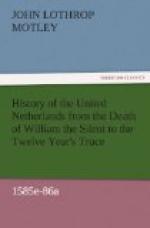It is also instructive to read that the light-fingered gentry of the metropolis were nearly as adroit in their calling as they are at present, after three additional centuries of development for their delicate craft; for the learned Tobias Salander, the travelling companion of Paul Hentzner, finding himself at a Lord Mayor’s Show, was eased of his purse, containing nine crowns, as skilfully as the feat could have been done by the best pickpocket of the nineteenth century, much to that learned person’s discomfiture.
Into such an England and among such English the Netherland envoys had now been despatched on their most important errand.
After twice putting back, through stress of weather, the commissioners, early in July, arrived at London, and were “lodged and very worshipfully appointed at charges of her Majesty in the Clothworkers’ Hall in Pynchon-lane, near Tower-street.” About the Tower and its faubourgs the buildings were stated to be as elegant as they were in the city itself, although this was hardly very extravagant commendation. From this district a single street led along the river’s strand to Westminster, where were the old and new palaces, the famous hall and abbey, the Parliament chambers, and the bridge to Southwark, built of stone, with twenty arches, sixty feet high, and with rows of shops and dwelling-houses on both its sides. Thence, along the broad and beautiful river, were dotted here and there many stately mansions and villas, residences of bishops and nobles, extending farther and farther west as the city melted rapidly into the country. London itself was a town lying high upon a hill—the hill of Lud—and consisted of a coil of narrow, tortuous, unseemly streets, each with a black, noisome rivulet running through its centre, and with rows of three-storied, leaden-roofed houses, built of timber-work filled in with lime, with many gables, and with the upper stories overhanging and darkening the basements. There were one hundred and twenty-one churches, small and large, the most conspicuous of which was the Cathedral. Old Saint Paul’s was not a very magnificent edifice—but it was an extremely large one, for it was seven hundred and twenty feet long, one hundred and thirty broad, and had a massive quadrangular tower, two hundred and sixty feet high. Upon this tower had stood a timber-steeple, rising, to a height of five hundred and thirty-four feet from the ground, but it had been struck by lightning in the year 1561, and consumed to the stone-work.
The Queen’s favourite residence was Greenwich Palace, the place of her birth, and to this mansion, on the 9th of July, the Netherland envoys were conveyed, in royal barges, from the neighbourhood of Pynchon-lane, for their first audience.




